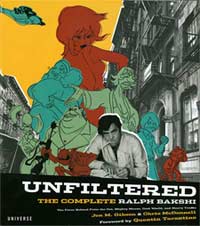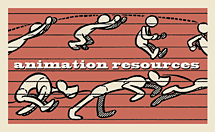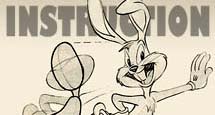This posting is a stub. You can contribute to this entry by providing information through the comments link at the bottom of this post. Please organize your information following the main category headers below….
Birth/Death
Wan Lai-Ming- Birth: January 18, 1899 , Death:October 1997?Wan Gu-Chan- Birth:January 18, 1899, Death: November 1995?Wan Chao-Chen- Birth: 1906 Death: 1992?Wan Di-Huan- Birth:1907
Occupation/Title
an Lai-Ming: Animator, Director and writer ?Wan Gu-Chan: Animator, Director ?Wan Chao-Chen: Animator, Art Director?Wan Di-Huan: Animator, Photographer
Bio Summary
The Wan brothers were born at the turn of the century in Nanjing, China. During their early years they put on puppet shows and experimented with art within the family’s home. Ultimately, they taught themselves how to animate; though, Chao-Chen did travel to America in the 1940s to study it academically. The twins Lai-Ming and Gu-Chan stuck together the longest career-wise; eventually they became the pioneers of Chinese animation. All four brothers reunited professionally for the final film in their Uproar in Heaven series. Then after, beginning in 1965, the Cultural Revolution in China halted all animation for almost ten years. The Wan brothers, especially Lai-Ming, were recognized for their efforts in animation and art by the Chinese government in the 1980s.
Early Life/Family
Their businessman father expected them to learn a trade from books, so they could be successful in life. Their mother, however, encouraged them to cut paper into the shapes of people and birds. When they were young, they performed stories, such as Journey to the West, in puppet shows with their paper characters. In 1916, the family moved to Shanghai, and Lai-Ming soon left for a job at the Shanghai Commercial Press.
Education/Training
Wan Lai-Ming taught himself animation and started making his own animated films by 1919 after viewing American cartoons, China’s shadow puppet plays, and cinematic techniques in live action films. In the late 1940s, Wan Chao-Chen traveled to America to study animation. He returned during the early 1950s, eventually directing a puppet animation, The Little Heroes (1953).
Career Outline
Lai-Ming worked at the Shanghai Commercial Press in both the Department of Fine Arts and the Department of Activities Movie Service beginning in 1919. After his brothers finished art school, they joined him at the Commercial Press, and together they made the advertising film, Shuzhendong Chinese Typewriter (1925). This film would be the beginning of their animation career.?The brothers worked under the Great Wall Film Company beginning in 1924, where they produced the first animated short film, Uproar in the Studio. This film utilized the techniques they witnessed in American cartoons, such as Fleischer’s Out of the Inkwell, by animating a cartoon character acting on an artist’s canvas. They believed that animation should be instructive and thought provoking as well as entertaining. Eventually, they hoped to develop an animation style that was uniquely Chinese. At this time, Di-Huan left the company to pursue a career in photography and to set up his own studio. In 1933, Lai-Ming, Gu-Chan, and Chao-Chen were hired by the Mingxing Film Company to set up an animation unit in Shanghai. They worked at this studio until 1937, when the Japanese capture of Shanghai shut down the studio. After the closure, they relocated to Wuhan province where they made patriotic animation for the China Film Production Firm. By 1939, Lai-Ming and Gu-Chan were invited to set up another studio in Japanese-occupied Shanghai. There they viewed Disney’s Snow White and the Seven Dwarfs, which inspired them to create a similar Chinese animated feature.?Production of the full-length animation took place in their new Xinhua United Film animation department. They decided on an adaptation of a story from the long Monkey King folk tale written in the sixteenth century. The result was Princess with the Iron Fan, a 76-minute cartoon produced in sixteen months by a team of 237 artists.?During the war, the remaining brothers worked on propaganda films, which combined war songs and animation. After the war, one by one the brothers returned to the Shanghai Animated Film Studio where they became directors. By 1956, Lai-Ming finished the first color cartoon in China, Why the Crow is Black-Coated, this film would later become the first Chinese animation recognized internationally. In 1961, Lai-Ming and Gu-Chan started work on an idea Gu-Chan had had before the war. This would later become the Uproar in Heaven series, which revisited the story in Princess with the Iron Fan and told the next part of the Journey to the West novel. All four brothers reunited professionally to work on the last of the series in 1964. ?In 1965, when the Cultural Revolution began in China, all art forms were put on hold. This eventually crippled the animation industry for almost ten years.
Comments On Style
During the 1930s, the Wan brothers utilized cut-paper and cel animation for entertainment and patriotic films. They also used live action mixed with cartoon animation to imitate the Fleischer Studio’s Out of the Inkwell series. For Princess with the Iron Fan, they enhanced the quality and sped up production by relying on Rotoscoping as well as traditional animation techniques and metamorphosis.?In 1958, Gu-Chan began work on a new technique of cut-paper animation, which was showcased in Pigsy Eats Watermelon. His technique relied on ancient folk art cut-paper designs rather than the origami styles being created at the same time.?For the final film the brothers worked on together, Uproar in Heaven, the Wans utilized many new artistic styles. They created simple backgrounds with vague shapes, but ones that would maintain the unity of rich colors throughout other elements of the film. The film also used motifs from Beijing Opera, such as movement and music. When the film was released, it was considered a metaphor for the current havoc caused in bourgeois China by the Chairman Mao.
Influences
The first influences that reached China were US animated shorts from the Fleischer studio. Therefore, the Out of the Inkwell series heavily influenced the Wan brothers’ earliest shorts. Later, more US animation including Popeye and Betty Boop reached China, influencing their styles further. The Wan brothers were then deeply influenced by Disney’s feature films. Most notably, Snow White and the Seven Dwarfs stirred them to begin a feature length Chinese animation.?Their films were also influences to other aspiring animators within Asia. Most notably, after viewing Princess with the Iron Fan, Tezuka Osamu was inspired to become a comics artist and later, an animator. It also prompted the Japanese Navy to commission its own animated feature film for Japan.
Personality
Anecdotes
Miscellaneous
Filmography
Shuzhendong Chinese Typewriter (1925) ?Studio in a Row (1926) their first silent animated short?A Paper Man Makes Trouble (1930) combined live-action and animation?The Prince of Blood (1932) anti-Japanese propaganda film?The Camel’s Dance (1935) China’s first sound cartoon?Patriotic films made while at Mingxing Company (1933-1937):?The Sad State of the Nation ?Aviation Saves China ?Detective Dog (1937) comedy for children?The Tortoise and the Hare (1937)?Patriotic films while at China Film Production Firm (1937-1938):?The Anti-Japanese War Special Collection ?Slogans of the Anti-Japanese War ?Songs of the Anti-Japanese War ?Princess with the Iron Fan (1941) China’s first full-length animation?The Little Heroes (1953) Chao-Chen’s puppet animation?Why the Crow is Black-Coated (1956) China’s first color animation of notable length?Pigsy Eats Watermelon (1958) Gu-Chan’s experiment with cut-paper animation?Uproar in Heaven (1961-1965) first color animation feature in China?The Golden Conch (1964) Guchan’s paper-cut animation
Honors
The brother’s film, Uproar in Heaven, won the Hundred Flowers Award in 1963 for best-animated feature. It also won the Best Film Prize at the London International Film Festival 1978.?Gu-Chan’s film, The Golden Conch, won the Lumumba Prize at the Asia-Africa International Film Festival in 1964. In the 1980s, the Wan brothers were awarded an honor by the Chinese government for their devotion to Chinese arts and filmmaking.
Related Links
Bibliographic References
“Princess Iron Fan.” Wikipedia: the Free Encyclopedia. ?http://en.wikipedia.org/wiki/Princess_Iron_Fan_(1941_film)









 by
by 





























